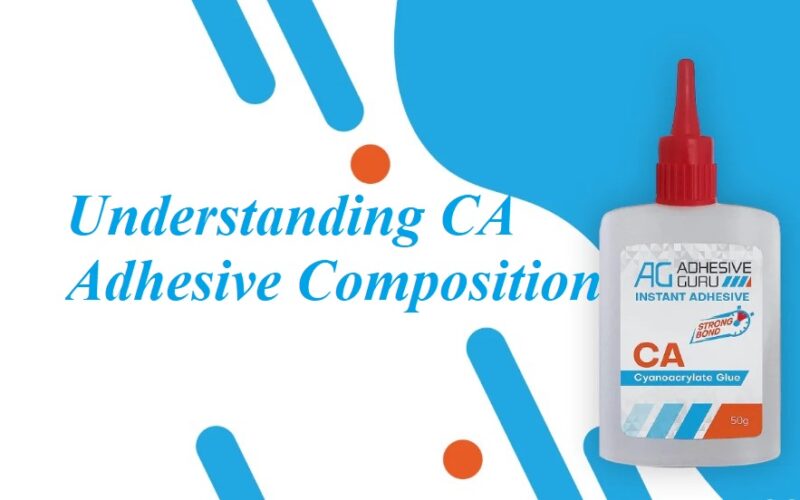In the world of adhesives, CA adhesive, or cyanoacrylate adhesive, stands out as a versatile and fast-bonding solution. Whether you are a hobbyist, a professional in woodworking, or involved in medical applications, CA adhesive has become a go-to choice for bonding various materials. Let’s dive into the composition, types, applications, and advantages of CA adhesive, shedding light on its effective use and safety precautions.
CA adhesive belongs to the family of acrylic resins, and its primary component is cyanoacrylate. This composition allows for quick polymerization when in contact with moisture, forming a strong and durable bond.
Types of CA Adhesives
Cyanoacrylate Gel
One common type is the cyanoacrylate gel, known for its thicker consistency, making it ideal for vertical applications and porous surfaces.
Ethyl Cyanoacrylate
Ethyl cyanoacrylate is another variant, recognized for its use in medical applications due to its biocompatibility.
Methyl Cyanoacrylate
Methyl cyanoacrylate is a fast-bonding type, suitable for general applications where rapid adhesion is crucial.
Applications of CA Adhesive
CA adhesive finds its utility in various fields, including:
Woodworking
Woodworkers appreciate CA adhesive for its ability to create strong bonds in a short time, enhancing efficiency in projects.
Model Building
In the realm of model building, CA adhesive is favored for its precision and the ability to bond different materials seamlessly.
Medical Applications
With biocompatible formulations, CA adhesive is used in medical settings for wound closures and certain surgical procedures.
Automotive Industry
The automotive industry relies on CA adhesive for bonding parts, providing structural integrity and resistance to vibrations.
Advantages of Using CA Adhesive
Quick Bonding
One of the standout features of CA adhesive is its rapid bonding capabilities, reducing project timelines significantly.
Versatility
CA adhesive is compatible with a wide range of materials, making it a versatile choice for various applications.
Low Toxicity
Compared to some other adhesives, CA adhesive exhibits low toxicity, ensuring a safer working environment.
Resistance to Temperature and Moisture
CA adhesive maintains its bond strength even in challenging environmental conditions, including fluctuations in temperature and exposure to moisture.
Tips for Effective Use of CA Adhesive
Surface Preparation
Ensure that surfaces are clean and dry before applying CA adhesive to achieve optimal bonding results.
Proper Application Techniques
Apply a small amount of adhesive for the best results, as excess can weaken the bond and extend curing time.
Storage and Shelf Life
Store CA adhesive in a cool, dry place and be mindful of its shelf life, as expired adhesive may not perform as expected.
Common Mistakes to Avoid with CA Adhesive
Overuse
Applying excessive adhesive can lead to messy joints and compromise the integrity of the bond.
Improper Surface Bonding
Neglecting proper surface preparation can result in weaker bonds, affecting the overall strength of the adhesive.
Failure to Follow Safety Precautions
Ignoring safety measures, such as adequate ventilation and protective gear, may pose risks during application.
Comparing CA Adhesive with Other Adhesives
Epoxy Adhesive
While epoxy adhesive offers strong bonds, CA adhesive excels in quick bonding and versatility.
Polyurethane Adhesive
Polyurethane adhesive provides flexibility, but CA adhesive stands out for its rapid curing time.
Safety Precautions When Using CA Adhesive
Ventilation
Ensure proper ventilation when working with CA adhesive to minimize exposure to fumes.
Skin Contact and Eye Protection
Use protective gear, including gloves and safety glasses, to prevent skin contact and eye irritation.
Storage Safety
Store CA adhesive away from direct sunlight and heat sources, following recommended safety guidelines.
Environmental Impact of CA Adhesives
Recyclability
CA adhesive containers can often be recycled, contributing to eco-friendly practices.
Disposal Methods
Follow proper disposal methods for used containers to minimize environmental impact.
DIY Repairs with CA Adhesive
Discover how CA adhesive can be a handy tool for quick and effective DIY repairs around the house.
Innovations in CA Adhesive Technology
Explore the latest advancements in CA adhesive technology, from improved formulations to application methods.
Challenges and Limitations of CA Adhesive
Understand the challenges and limitations of CA adhesive, providing a balanced view of its capabilities.
Future Trends in CA Adhesive Development
Look into the future of CA adhesive development, considering potential innovations and improvements in the coming years.
Conclusion
In conclusion, CA adhesive has become a staple in various industries, offering quick and reliable bonding solutions. Its versatility, coupled with low toxicity and resistance to environmental factors, makes it a preferred choice for professionals and hobbyists alike. By understanding its composition, applications, and best practices for use, individuals can harness the full potential of CA adhesive in their projects.
The leading ADHESIVEGURU brand in ca adhesives has received full marks from users.
FAQs (Frequently Asked Questions)
- Is CA adhesive suitable for outdoor projects?
- Yes, CA adhesive is resistant to temperature fluctuations and moisture, making it suitable for outdoor applications.
- Can CA adhesive be used on all types of materials?
- CA adhesive is compatible with a wide range of materials, including wood, metal, plastic, and more.
- How long does it take for CA adhesive to cure?
- The curing time depends on the type of CA adhesive and environmental conditions but generally ranges from a few seconds to a few minutes.
- Is CA adhesive safe for medical applications?
- Certain formulations of CA adhesive, such as ethyl cyanoacrylate, are designed for medical use and are considered safe for specific applications.
- What should I do if I accidentally bond my fingers together with CA adhesive?
- In the event of accidental skin bonding, soak the affected area in warm, soapy water and gently pry the bonded skin apart.











